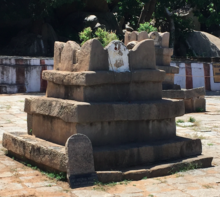Padmanabha Tirtha
Padmanabha Tirtha | |
|---|---|
 | |
| Personal | |
| Born | Shobhana Bhatta Present day North Karnataka[1] |
| Religion | Hinduism |
| Order | Vedanta |
| Philosophy | Dvaita Vedanta |
| Religious career | |
| Guru | Madhvacharya |
Disciples | |
| Part of a series on |
| Dvaita |
|---|
 |
| Hinduism portal |
Padmanabha Tirtha (attained Siddhi 1324) was a Dvaita philosopher, scholar and the disciple of Madhvacharya. Ascending the pontifical seat after Madhva, he served as the primary commentator of his works and in doing so, significantly elucidated Madhva's terse and laconic style of writing. His pioneering efforts in expanding upon the Dvaita texts to uncover the underlying metaphysical intricacies was taken forward by the 14th Century philosopher, Jayatirtha.[2] Padmanabha is also credited with disseminating the philosophy of Dvaita outside the Tulunadu.[3]
Life[]
According to Narayana Pandita's Madhva Vijaya, Padmanabha, born Shobhanabhatta, a Deshastha Rigvedi Brahmin, was an accomplished scholar and logician. Scholarly opinion mostly places the location of his birth to the region of North Karnataka.[4] After being won over by Madhva in a debate, he adopted Dvaita and was subsequently tasked by Madhva to disseminate the nascent philosophy across the subcontinent.[3] After his death, he was entombed at Nava Brindavana near Hampi. His disciple Narahari Tirtha succeeded him as the pontiff.
Works[]
15 extant-works have been ascribed to him, most of which are commentaries on the works of Madhva. His notable works include Nyayaratnavali, a commentary on Madhva's Vishnu Tattva Vinirnaya, Sattarkadipavali a gloss on Bramha Sutra Bhashya and Sannyayaratnavali on Anu Vyakhyana. Sharma notes "dignity, elegance, clearness, brevity and avoidance of digression and controversies mark his style".[5] Though Jayatirtha later diverges from Padmanabha's views, he eulogies the latter's pioneering work in his Nyaya Sudha and acknowledges his influence. Padmanabha's influence is also acknowledged by Vyasatirtha, who attempts, in his Tatparya Chandrika, to reconcile Jayatritha and Padmanabha's views.
See also[]
- Dvaita Literature
References[]
- ^ Sharma 2000, p. 223.
- ^ Sharma 2000, p. 294.
- ^ a b Wilson 1876, p. 82.
- ^ Sharma 2000, p. 293.
- ^ Sharma 2000, p. 295.
Bibliography[]
- Sharma, B. N. Krishnamurti (2000). A History of the Dvaita School of Vedānta and Its Literature, Vol 1. 3rd Edition. Motilal Banarsidass (2008 Reprint). ISBN 978-8120815759.
- Wilson, H.H (1876). Sketch of Religious Sects of the Hindus. Bishop's College Press.
External links[]
- Medieval Hindu religious leaders
- Hindu revivalists
- Kannada literature
- Madhva religious leaders
- People from Bellary district
- Dvaitin philosophers
- Dvaita Vedanta
- Uttaradi Math
- Writers from Karnataka
- Scholars from Karnataka
- 14th-century Indian scholars